Magnetism
Summary
Magnets are attracted to certain metals and other magnets. Students feel the attractive and repulsive forces of magnets. Students can observe a magnetic force field by lining iron filings up with magnets. The north and south poles of a magnet can be determined by comparing them to the Earth's magnetic field. Magnetizing a needle and floating it on water makes a floating needle compass.
Materials
Attachments
- Student worksheet
- Assorted magnets. Each group should have at least 2 different magnet sets; magnets may be purchased from many different manufacturers. At least one of these sets should be about the size of a small paper clip.
- Magnetite (1 piece per group), Carolina.com GEO3476B pack of 10 for $16.75
- Paper clips, pennies, any objects made of stainless steel like forceps or spatulas, nickel wire (enasco.com, SB10529M, $9.30 for 125 feet) and/or other objects made of different types of metal.
- Thread
- Iron filings, enasco.com, S06119M, 1 lb for $3.40, they are easily dispensed if transferred to a saltshaker.
- 3 petri dishes per group
- Tape and white paper for each group
- 2 non-magnetized sewing needles per group
- Styrofoam or cardboard
Background for Teachers
A magnet is a metal object that is able to pull or attract certain other metals. This pull or attraction is a force called magnetism. Weak magnets naturally occur in nature; the mineral lodestone or magnetite (a magnetic oxide of iron) was the first magnet used around 800 BC. Stronger magnets used today in electronic devices or in other ways are manmade.
Magnets exist because when the electron spins in an object are all aligned in the same direction the material is magnetized. Normally, these electron spins are not aligned and the magnetic field is scattered. When the minor magnetic fields are scattered, no magnetic field is generated because the small magnetic fields cancel out. Therefore, in a magnet when the poles line up with the north poles facing one end of an object and the south poles facing the other end. This arrangement creates a magnet. The more domains pointing in the same direction creates a stronger magnet.

Attraction is the pull force a magnet has for another object. You can't see this force - but you can feel it. This object a magnet is attracted to may be a metal or another magnet's opposite pole. When a magnet gets near a metal it is attracted to, the electrons in the metal are realigned and their small magnetic domains line up to be attracted to the magnet. This attraction is temporary. After the magnet is removed from the metal the objects will randomly scatter their magnet poles back to where they were before they were attracted to the magnet. A magnets strongest area of attraction is at the poles.
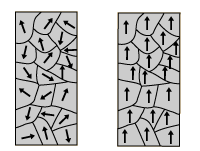
Repulsion is the pushing away force a magnet has for another magnet lined up in the same direction. These attractive and repulsive forces create a magnetic force field around every magnet. These force fields are invisible but can be seen by placing magnets near iron filings. The iron filings will line up along the magnetic force field.
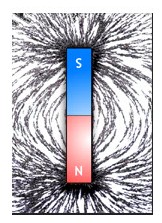
Intended Learning Outcomes
1d. Compare things, processes, and events.
1h. Predict results of investigations based on prior data.
3a. Know and explain science information specified for the grade level.
4b. Describe or explain observations carefully and report with pictures,
sentences, and models.
4c. Use scientific language in oral and written communication.
Instructional Procedures
Attachments
Pre-lab discussion: Ask the students about their previous knowledge of magnets. Show them a strong pair of magnets so that you can demonstrate the attraction and repulsion of the magnets. Discuss uses for magnets in their everyday lives. How many magnets do they think are in the room? (iPods, computers, monitors, televisions, cell phones, etc) Diagram and explain the notes given in the background information section.
Instructional procedure:
Experiment 1: Magnet Properties
- Take two magnets and have them attract and repel each other. Feel this force between the two magnets.
- Take one magnet and one piece of magnetite. Test the following objects with both magnets: paper clip, penny, tip of a pencil, pyrite (47% iron), nickel wire (0 % iron), and stainless steel (70% iron).
- When you test these materials, compare the strength of the manmade magnet to the naturally occurring magnetite. Also, test the ability of the two objects to pull the objects they are attracted to without actually touching them.
Experiment 2: Finding the North and South Poles of a Magnet
- Find out which direction is north in the classroom. Tie one end of a piece of
thread, ½ meter long, to a paper clip. Fasten the clip to the center of one of the
rectangular magnets. Dangle the magnet above the table, being sure no other
magnets are nearby. Steady the magnet.
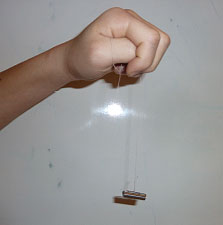
- The end of the magnet that settles and points towards north in your room is called the north pole of your magnet. Put a small piece of masking tape on the north pole of your magnet. While still dangling your magnet, point the north pole towards south and observe how the magnet behaves.
- Mark two magnets in this way. Touch your magnets to each other again and notice that opposite poles attract and like poles repel.
Experiment 3: Magnetic Fields of Permanent Magnets
A magnetic field is the area in which a magnetic force is present. We can't see magnetic fields, but we can show their pattern by scattering iron filings in the magnetic field. The iron filings then become magnetized and line up with the magnetic field of the magnets.
- Tape two magnets to a piece of white paper. Tape them about two
centimeters apart, so that the north pole of one magnet faces the south pole of
the second magnet. Turn over the top of a petri dish and place it over the
magnets.

- Place some iron filings into a petri dish. Put the lid on the petri dish and tape it together so that the iron filings can't get out and stick to the magnets.
- Place the petri dish with the iron filings on top of the petri dish over the
magnets.
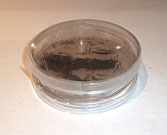
Gently tap the petri dish until the iron filings form a pattern. Discuss the pattern created by the magnetic field.
** Be careful that the iron filings do not get on the magnets.
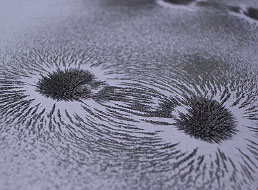
- Change the direction of one of the magnets so that two similar poles are
facing each other. Repeat the experiment. Discuss the pattern created by the
magnetic field.
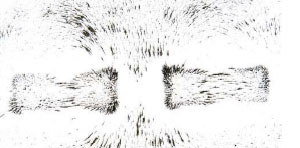
Notice that when the two magnets attract each other, the iron filings can be found in the space between the two magnets. When the two magnets repel each other; the iron filings are repelled from the space between the magnets.
Experiment 4: Making a floating compass - Sailors used Floating compasses as early as the thirteenth century. The sailors used the floating needle to find north during cloudy weather when they couldn't see the stars.
- Place a petri dish on a non-metallic table. Fill the petri dish ¾ full with water.
- Stroke two needles, one at a time, along the magnet. Be sure you always stroke the needle lengthwise in the same direction down the magnet. Stroke the needle a total of 20 -- 30 times.
- Place all the magnets onto a different desk so they do not interfere with your compass. Push one magnetized needle through a small piece of cardboard from an insulated coffee cup.
- Carefully lower the floating needle onto the surface of the water. The needle should float. Watch the needle and look at which direction the needle is facing once it stops moving. One end of the needle should be facing north and this is now the north pole of your needle.
- Now bring the second magnetized needle up close to the one on the water. What effect does the second needle have on the floating needle? Figure out which is the north and South Pole of your second needle and see if you can make the needle spin.
- Bring a magnet near the magnetized needle compass. Notice that the
magnet will overpower the magnetic field of the earth and pull the needle
towards it.
This temporary needle magnet or any magnet is stronger than the earth's magnet at short distances. This is observed when the second needle can override the magnetic field of the earth and disrupt the compass. But the earth's magnetic field is much farther reaching since it goes from the center of our earth all the way to our petri dish needle while our two needles only react with each other over a very short distance.
Bibliography
Rio Tinto Hands-on Science Curriculum Team
- Ms. Rae Louie -- Administrator, Principal Beacon Heights Elementary
- Emily Mortensen -- Grant writer, teacher outreach, 2nd grade teacher at Beacon Heights Elementary
- Ruth Li -- Curriculum design, K-6 Science Educator at Indian Hills Elementary
- Deirdre Straight -- Curriculum development, K-6 Science Educator at Beacon Heights Elementary
- Tim Rausch -- Website development, Library Media at Beacon Heights Elementary
Updated: 10/06/2022


 UTAH EDUCATION NETWORK
UTAH EDUCATION NETWORK

 Justin
Justin Braxton
Braxton Dani
Dani Kayla
Kayla Katie
Katie Matthew
Matthew Rob
Rob Val
Val
